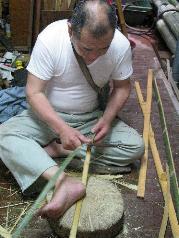|


| Attention to Akeni
|

|
Carolyn Todd
SFM's newest addition to the writing staff takes an
in-depth look at akeni, their history and production techniques
|
|
| Rikishi of Old
|

|
Joe Kuroda
Joe Kuroda slides former yokozuna Minanogawa under his SFM microscope |
|
| Eric Evaluates
|

|
Eric Blair
Eric's wit scythes through the SML and makes clear his opinion of where the future lies for online sumo forums. |
|
Eternal Banzuke Phase II
|

|
Lon Howard
Stats, equations and mathematics all lead to a list of sumo's most prolific up and downers
|
|
|
|
|
Heya Peek
|

|
Mark Buckton
Mihogaseki, former home of Estonian sekitori Baruto is toured (and peeked at) by SFM's Editor-in-Chief
|
|
|
|
|
|
|
Nagoya Basho Summary
|

|
Lon Howard
Lon gives us his Nagoya basho summary, along with the henka sightings results
|
|
|
Lower Division Rikishi
|

|
Mikko Mattila
Mikko Mattila casts his watchful eye over lower division goings on in makushita and below.
|
|
|
Aki Ones to Watch
|

|
Carolyn Todd
Carolyn takes over the job of rikishi job performance prediction for SFM as she looks at those to keep an eye on come September |
|
|
Kimarite Focus
|


|
Mikko Mattila
Our man Mikko's latest trio of kimarite get thrown about the SFM literary dohyo |
|
|
Amateur Angles
|


|
Howard Gilbert
Howard returns with the second of his columns on the amateur sumo scene.
|
|
|
Sumo Game
|

|
| SFM's very own quiz comes in for a bit of self scrutiny by our secretive man of questions. We'll call him 'X'. |
|
|
Sumo in Print
|

|
Barbara Ann Klein
SFM’s Editor reviews “The Little Yokozuna”, a book for “young” (and older) adults
|
|
| Kokugi Connections
|

|
Todd Lambert
Check out Todd's bimonthly focus on 3 of the WWW's best sumo sites
|
|
Fan Debate
|
 
|
Facilitator - Lon Howard
Keri Sibley and Eduardo de Paz ponder the concept of ‘to pay or not to pay’ makushita salaries
|
|
SFM Cartoons
|  |
Stephen Thompson
Sit back and enjoy the offerings of one of sumo's premier artists |
|
Lets Hear From You
|
 
|
| What was it that made you a sumo fan? SFM’s own Todd Lambert details his path into sumofandom
|
|
|
|
| Sumo Quiz |
The Quizmaster
Answer the Qs and win yourself next basho’s banzuke. |
|
|
|
 |
Attention to Akeni
by Carolyn Todd
Photos by Carolyn Todd
|
 |

|

|
cabinet to breathe but the frame
made it sturdy. Only two of these cabinets are still in existence. They
were popular in Tokyo but during WWII they were mostly destroyed.

Peeling Bamboo
Mr. W’s father used to work as a craftsman for a company, but he was
frustrated as an employee and started his own workshop in 1932. At that
time, boxes, and most other craft items, were made through the division
of labour. Each craftsman had a different role: one would
make the frame; Mr. W’s father wove the bamboo, then passed the box
along to the next craftsman who applied the washi paper, and so on
until the boxes were finished.
Next
 |
|
|
 |
 In most sports, competitors tote their equipment, boots, racquets, or
whatever, in technology-riddled bags produced by sports company
sponsors. In sumo, however, they have to make do with bamboo and paper
boxes designed in the Edo period (1603-1867). Unless you’ve got
Japanese TV or you’ve seen a bunch of dressing room photos, you might
never have seen these bright red and green boxes, known as akeni, which
hold the kesho mawashi (the long, elaborate “apron” worn during the
dohyo-iri), mawashi, and anything else a sekitori needs during a basho,
but they’re yet another example of the history and tradition
surrounding sumo. And, instead of multinational companies using
multitudes of employees to churn out bags by the gazillion, sumo relies
on the craftsmanship of only two men, Takekazu Watanabe and his son,
Yoshikazu.
In most sports, competitors tote their equipment, boots, racquets, or
whatever, in technology-riddled bags produced by sports company
sponsors. In sumo, however, they have to make do with bamboo and paper
boxes designed in the Edo period (1603-1867). Unless you’ve got
Japanese TV or you’ve seen a bunch of dressing room photos, you might
never have seen these bright red and green boxes, known as akeni, which
hold the kesho mawashi (the long, elaborate “apron” worn during the
dohyo-iri), mawashi, and anything else a sekitori needs during a basho,
but they’re yet another example of the history and tradition
surrounding sumo. And, instead of multinational companies using
multitudes of employees to churn out bags by the gazillion, sumo relies
on the craftsmanship of only two men, Takekazu Watanabe and his son,
Yoshikazu.
All sumo wrestlers strive to obtain
their first akeni and kesho mawashi as a rite of passage and
|
|

|

|
symbol of
their success, as only juryo and makunouchi wrestlers and gyoji are
permitted to use them. Gyoji order their own akeni through their heya
when they are promoted, but sekitori akeni are ordered by sponsors.
Akeni cost 100,000 yen per box from Mr. Watanabe (hereafter, “Mr. W”)
but kesho mawashi makers sell akeni and kesho mawashi as a set, bumping
up the price considerably. And what do you get for your yen? Akeni
weigh about 15kg (33 pounds) empty and measure approximately 80 x 45 x
30 cm (31.5 x 18 x 12 inches), the perfect size to hold a kesho
mawashi.
This type of bamboo and paper box arrived from China around the 15th
century. The oldest type of this box is called a tsuzura, and they were
originally used to store clothes, traditionally kimono, because there
were no closets. Then
a cabinet was developed with a wooden frame covered with the same woven
bamboo as the boxes. This allowed the
 |
 |
|






